When you look down into your pool skimmer, you may see two holes, one at 12 o’clock and another opposite hole, at 6 o’clock. This gives the pool builder some flexibility in how to connect the plumbing pipes underneath the skimmer.
They can run a pipe from the main drain into the front hole of the skimmer, and then the back hole is the suction pipe that goes to the pool pump.This reduces costs, compared to running a separate main drain pipe, all the way back to the pump.
Here’s some common inground pool skimmer plumbing configurations that you may encounter. I have shown these skimmers connected with schedule 40 pvc, although on some pools you may encounter flex pipe, or black poly pipe being used, which is sub-standard to PVC.
Combination Skimmers
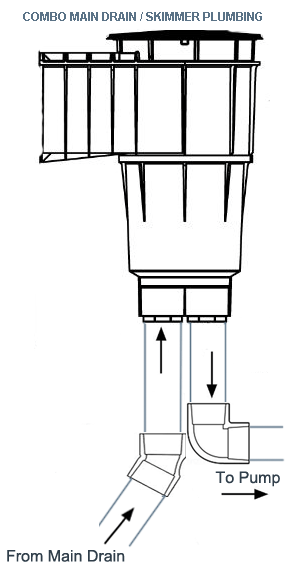
Combination Skimmers, or Combo Skimmers, as I like to call them, have the main drain tied into the front hole of the skimmer, on the pool side, and the back hole, or the deck side hole is connected to the pipe that runs back to the pump.
This type of arrangement requires an additional skimmer accessory to help control the flow coming up from the main drain pipe, and the flow coming “top-down”, through the basket – or, the skimmer flow.
Two main types of diverters are used in a combo pool skimmer. Hayward uses a Float Valve, which some pool guys I know like to call a Turtle or a Spaceship.
There is a flap on the bottom of the float valve that allows you to have some control of how much flow is from the main drain, and how much flow is used for skimming action.

The second type of diverter is just the flap, called a Trimmer Plate, which is screwed onto the bottom of the skimmer. Slide the flap over the main drain pipe to reduce flow from the main drain, ‘bottom-up” while increasing the skimming action, or “top-down” flow into the skimmer.
Winterizing this type of Combination skimmer involves blowing air through the main drain hole, and then (very) quickly switching the air hose with a winter plug, tightened up very quickly, before the water rebounds up into the pipe. Then connect the air hose to the rear hole and blow out the pipe to the pump.
Common Skimmer Plumbing
This type of skimmer plumbing arrangement is among the most commonly used. The second hole, usually the hole on the pool side of the skimmer is plugged off with a threaded plug from underneath.
Many times the plug is a few inches below the bottom of the skimmer, and it fills with rocks and debris, making it appear as though it is not plugged. To determine if you have this type of arrangement, stick your fingers (or a screwdriver) down into the hole and see if you can feel the plug.
With this type of single hole use of a pool skimmer, the line that leads to the pump will usually have a valve in front of the pump to control the water flow from this skimmer, and if you have a second skimmer, usually one 3-way valve is used to control both skimmers. In this way, the two skimmer pipes connect underground with a Tee fitting, and then one pipe runs back to the pump.
Because the main drain is not tied into the skimmer in this set-up, pool systems using this configuration usually also have a separate valve to control a separate main drain line that runs from the pool to the pump.
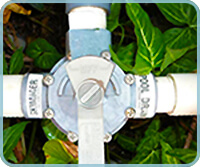
To winterize this common skimmer plumbing style, connect an air hose and your Cyclone blower into the open skimmer pipe (usually the rear hole). Blow air from the skimmer to the pump. If you have more than one skimmer, turn the valves at the pump in such a way to direct air back to the second skimmer. For Jandy-type valves, loosen the handle knob, to pull the handle above the lid-stops, placing the valve backwards, in ‘dead-head’ fashion. You can also plug the pipe that comes into the pump basket, or place a filter multiport valve into the Closed position.
Old Style Combination Skimmer Plumbing:
Anthony Pools & Sylvan Pools
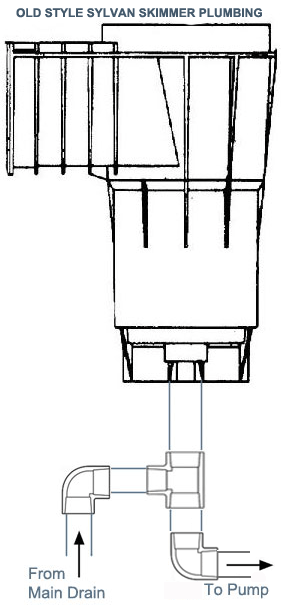
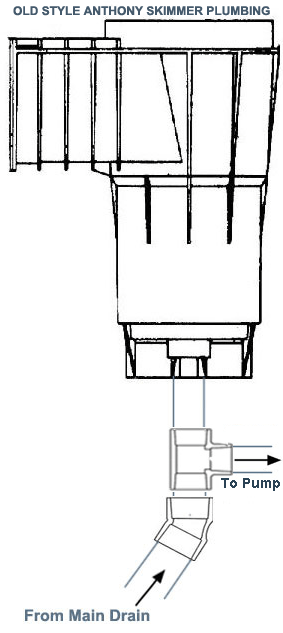
Old Style Anthony Skimmers used a long diverter that screws into a single, center hole, or sometimes they used a two-hole skimmer and plugged the hole on the pool side. With a 1/4 turn of the diverter, you take it from Full Main Drain to Full Skimmer. This design was fairly effective to control the skimmer and main drain flow, as long as the diverter was being used. Winterizing an Anthony skimmer requires two plugs, an extended #8 to plug the drain, and a #10 to plug the skimmer (at the top of the hole). First blow and plug the main drain, then blow out the skimmer line and plug.
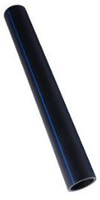
Old Style Sylvan Skimmers used no diverter, and therefore had no control of the flow amounts from the skimmer and the main drain. To vacuum the single hole Sylvan skimmer, one would use a piece of 1″ black poly pipe, 12″ long. The pipe would hit the bottom of the tee (not shown) and stick up just enough to attach your vacuum hose. Old style Sylvan skimmers were commonly plumbed using black poly pipe, and some of the original sylvan skimmers were made of aluminum. A special double-plug is used for winterizing these skimmers, with limited effectiveness. When the main drain begins to blow strongly, the double plug is slammed-fast into the hole, which seals both drain and skimmer at the same time.
Equalizer Line Plumbing
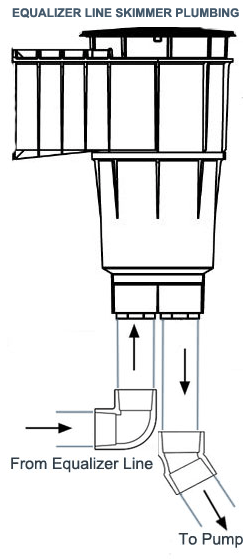
Back in the day, it was common (not so much anymore) to plumb the skimmer with a built-in low water protection, known as an equalizer line. The equalizer line is a suction line installed below the skimmer, about 18″ below the tile line.
The purpose of an equalizer line arrangement was to allow the skimmer to keep operating if the pool water level drops below the opening to the skimmer. A spring loaded valve was usually screwed into the front hole of the skimmer, on the pool side. This valve would open up if the skimmer started to suck air.
Not commonly used in public or private pools anymore, this particular pool skimmer configuration is more or less a thing of the past. They can be plugged, if not needed. Or you can open the line and with the use of a diverter, treat it as a LWS, or low water suction line, to help improve circulation, if needed.
If the pool skimmer for your pool needs to be replaced, check out our skimmer selection at In The Swim. We carry many types of wall skimmers for both inground and above ground swimming pools.


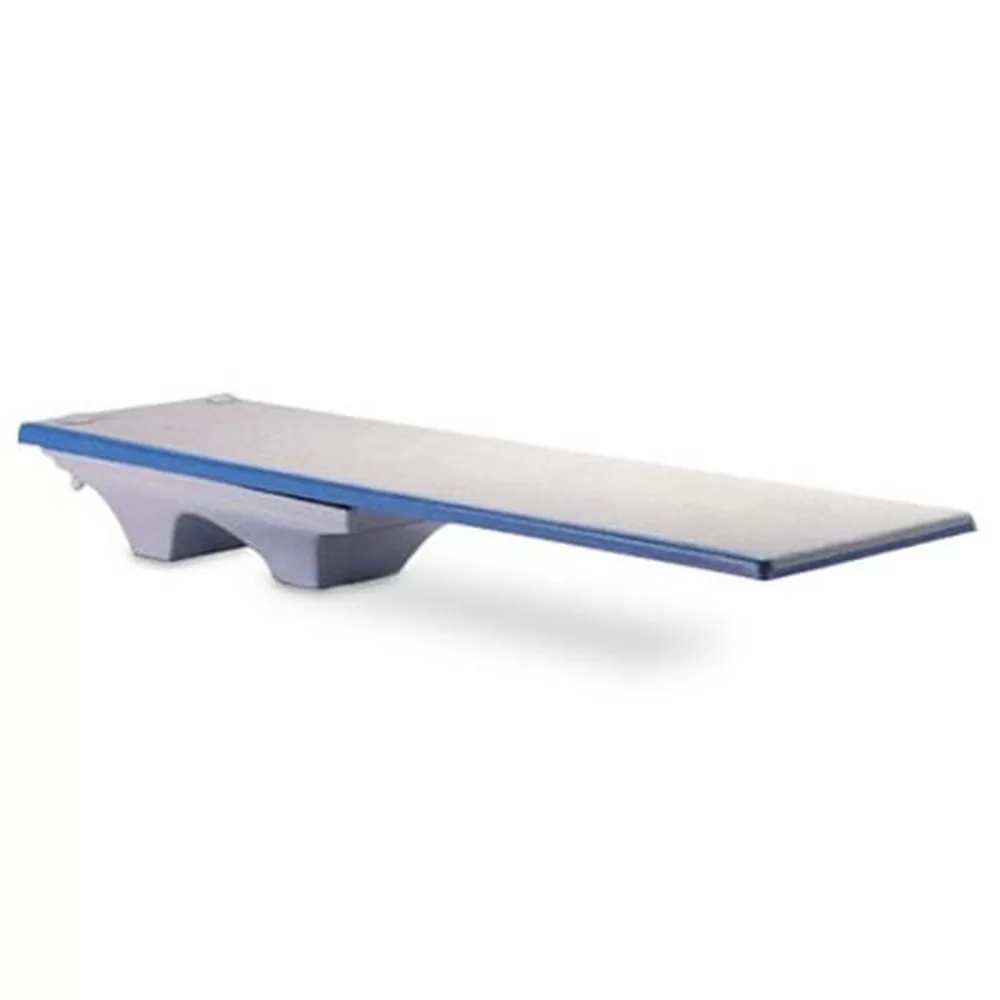
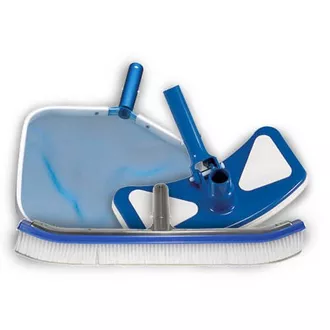
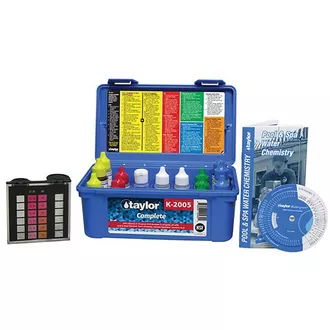




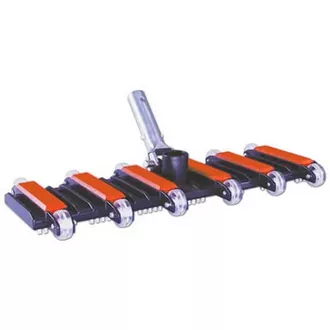
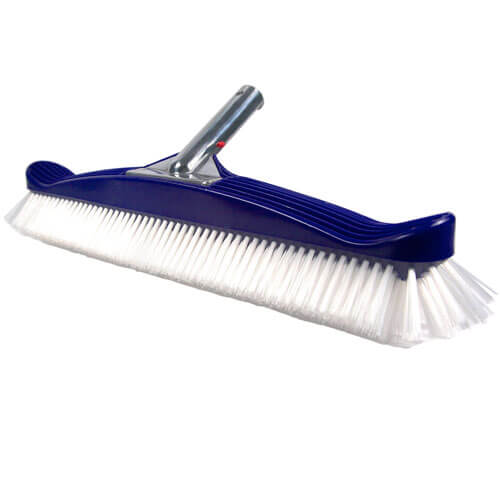
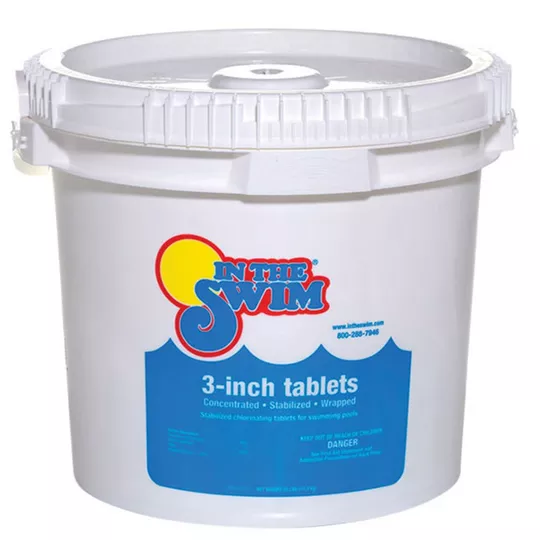
Hi, I just winterized my pool for the first time. I just need to confirm a few things. To start, the main drain has been covered over by the new liner that was put in 2 years ago by the previous owners, which seems fine. I’ve also found that if I leave the equalizer hole unplugged the pool will drain. I’ve actually unplugged the equalizer hole to start my draining process for winterizing but I just wanted to make sure it’s ok to drain the water that way since I’m guessing the equalizer line was disconnected from the main drain and must just feed into the ground. There’s no other place for it to go. I also know that the previous owners didn’t use a gizmo in the skimmer last winter and I’m guessing it’s because they left the equalizer hole unplugged thereby allowing any rainwater to drain. I found this confusing at first but now understand how they could get away without the use of a gizmo. They don’t seem careless. Does this make sense and is my process ok?
Hi Blaine, it would be best not to use the equalizer line to lower the water because if it’s draining under the pool or under the deck, over time, it could cause some erosion or corrosion, or if the water does not move on, downhill, but gets trapped in a spot that has not had moist soil in years, or for the past year, that can sometimes have undesired consequences with concrete pools and concrete pool decks. When dry soils become suddenly wet, they swell, and when cold, they freeze and expand even further, this can put pressure on pools and decks. So unless you know it’s running out somewhere fine, it would be best to use a siphon overnight, or a small pump to lower water. Gizmos are used as a combination skimmer plug (use Teflon tape) and Ice Compensator, or ice absorber. They are designed to absorb the pressure from expanding ice in the skimmer, by collapsing a bit, to prevent outward pressure of ice on the skimmer walls. A 32 oz chemical bottle filled 1/4 full with pool antifreeze or gravel will do the same thing.
I have an old anthony style skimmer and am a bit confused on how to winterize. When you say blow and plug main drain, is that coming from the pump side or from the skimmer? I don’t know how from the skimmer you would blow out the main drain and then be able to plug it before it fills with water.
For an Anthony old-style, you first reach down with an extended #8 plug to plug up the main drain, then connect the blower to the skimmer and blow towards the pump. For an old-style Sylvan pool, you use a Double Plug held in place by a helper, and blow from the pump towards the skimmer, and once the drain starts blowing, the helper will slam the double plug down and tighten the wing nut.
Hi my parents have in ground and was running great til bout 1 week ago. Suddenly my Hayward super pump does not retain water and I’m getting air only in my backwash hose. I might add that this is also sand filter. They do have the two holes in skimmer but I’ve got no suction. Checked for air leaks but I’m still confused about hosing and connections.
One goes from filter to pump, another comes up from under cement close to pool and that connects to the filter. But I’ve also got another one that is under deck that connects to the front of the pump. My dad just passed away as he Normally takes care of , so I’m unable to close pool as backwash not successful. Any tips
The pipe that connects to the pump is FROM the pool, the pipe that connects to the filter is TO the pool. If no water is flowing into the pump when it is turned on, check that the pump lid is very tight, with the lid o-ring in place and lubed. Be sure that the pool water level is mid-skimmer. Open the air bleeder on the filter tank to relieve some pressure. If it won’t start on backwash, try starting on the Recirculate or Waste setting on the filter valve. You may need to prime the pump, which is to open up the pump and fill the basket with water from hose or bucket. Be sure that pump basket is inserted properly, so that debris cannot bypass it to clog the impeller. If it still wont start after priming many times, there may be a loose pipe fitting, that threads into the pump. Pool Putty, or silicone can seal up such leaks, temporarily at least.
My daughter just bought a house with a inground pool with a bottom drain that has lots of leaves being sucked to it.I can’t find a valve to switch to skimmer so it stops sucking so t can clean the bottom drain.IHave a 40yr.old in.gr.pool with no bottom drain,but most pools I’ve seen have a valve you can switch from skimmer to drain or back to vacume.I know how to take care of a pool as I have had old ones for 40yrs.but not familiar with this one,how can switch to skimmer?Thanks.
Glenn, if there is not a dedicated, separate line to the pump for the main drain, but just one pipe coming into the pump, that means that the main drained ‘is tied into the skimmer line’, underneath the skimmer, and likely in one of the plumbing configurations outlined above. If there are two holes (both connected to pipes, front hole not plugged), then you can just plug the front hole to shut off the main drain suction. If it is a single hole in center bottom of the skimmer, then you would need an extended #8 plug and some long needlenose or thin straight pliers, to reach down and plug the hole that continues down to the main drain, just below the horizontal port for the skimmer line.
We just recently had a pool built. After filling with water, the levels dropped a bit and one skimmer started making a lot of bubbling noise. When looking at it, the water was below the skimmer. However, the other one was smoothly taking in water. Upon investigation, one skimmer is 1.5’’ below the other. So one can take a much lower water level than the other. My builder adjusted the auto fill up so that the minimum water level is now only 2 inches below the coping. Does this sound okay or like it will cause additional problems? It seems strange to have the water level this high on an ongoing basis and I also worry the skimmers won’t pull at the same rate.
Hi Summer, I have seen many pools like that, kind of a rookie builder mistake actually, but something you can deal with. The only issue with the solution is that when you get heavy rains, it won’t take long for the skimmers to stop skimming. And you may find yourself lowering the water level a lot, if you live in a rainy area. IF so, perhaps the builder will agree to pop a hole in the top of the skimmer rear well, and connect a pipe, under the deck, to automatically lower high water levels, by draining off, thru a 1″ PVC pipe. But still, one skimmer will be stronger than the other. To remedy that, for the skimmer set more deeply, which may now have less pull, you can look at the SkimDoctor product, which might be a good answer.
I have old style sylvan skimmers and they seem to be aluminum. I am seeing clear jelly like substance in the basin when I remove the skimmer. Also this stuff is in the skimmeR. Is the aluminum
Skimmer disintegrating or is this some kind of algae?
I also believe there is some rust (if that’s possible)
Hi Janice, the aluminum skimmers used back then will disintegrate over time. They do not rust, but will scale, and crumble around the edges. Not sure what the jelly stuff is, perhaps some reaction of the aluminum with something else, not sure…
My skmiier only has a hole. How do I go about attaching the vacuum to it? The old owner had a contraction that doesn’t seem to work to get it working,As the vacuun tube would not fit into the skimmer hole. Should I replaced the sinner and is this expensive
Replacing an inground skimmer is expensive, maybe $1500 or more, as they are encased in concrete, and under a concrete deck, in most cases. We have two skimmer diverters, that are used to switch between skimmer and main drain suction, search part number 85002600 and SPX1075L, both on our website. Old Style Sylvan used a 1.25″ vacuum pipe, that is just a black pipe that is inserted into the skimmer, and then the vacuum hose is connected, or slips over the black pipe. We don’t sell that, but you can get a short section of 1.25″ pipe and make your own, it need not be black.
I have a very old Anthony in ground pool. My skimmer is missing the diverter valve. I’ve ordered from 4 different places and they are all too big. How do I get the correct diameter?
Hi, you must be using the Pentair diverter, which is very similar but a little bigger. Val-Pak makes an aftermarket diverter for Anthony Skimmers, the type with a single hole in the center bottom. We don’t carry it but I see it online here – https://poolsupplyworld.com/val-pak-products-valve-diverter-anthony/34115.html
Our first pool and am a little confused at how it is plumbed for the main/vacuum/skimmer. The question comes up initially as it looks like when the pool is cleaning the float valve keeps the skimmer from pulling into the basket. It floats up when just sitting in water but when the pump starts up there really isn’t any impactful suction from the weir opening. So under the skimmer basket are two holes. I have a separate vacuum line which seems to work fine. There’s also a separate pool water level hatch. I took the float valve out and it seems to make a big difference in the suction of the skimmer and the vacuum works fine still. Is this ok or am I putting my pool pump and plumbing in danger if the water level drops too low? Or is the float switch necessary/recommended but not working well? Thanks!!
Dave the Float Valve, aka Turtle, aka spaceship, is a diverter to allow control of the flow from the skimmer and the main drain. The main drain is connected (most often) to the front hole, and the rear hole goes to the pump. Without the Float Valve, most of the suction going into the rear hole will be from the top down, the path of least resistance. The Float Valve has a (or should have), a throttling plate screwed into the bottom that covers (or uncovers) a hole, in the bottom of the Float Valve. When the plate is not covering the hole, most suction will be from the drain, but if you open the plate, that will allow skimmer suction, while still pulling some from the main drain.
I’ve got an old Anthony style skimmer, and was wondering how would a I go about vacuuming the pool if the diverter valve is bot present…There looks like it has no provision for the valve in the bottom of the skimmer. Could i use the main drain on the spa to stick my vacuum hose?
Thank you
Hi, for an Anthony pool, we have the diverter that is used, SPX1075L https://intheswim.com/p/multi-flo-valve-control/605744.html Please don’t remove the drain cover to vacuum with, that could create an unsafe condition.
Built in 1962, our swimming pool (5 lane, 25 yard + dive tank) has the equalizer line skimmers. For years, we have had poor skimmer action and believe there is blockage in the lines. Original skimmer lines had been converted to PVC in the 1990’s.
How in the world can I purge those lines?
Hi Bruce, if the skimmer action has gradually decreased over time, it could possibly be a clog, but also possibly a collapsed skimmer line, if they used Flex PVC pipe and not rigid PVC pipe. See this post: https://blog.intheswim.com/sylvan-pool-flex-pipe-skimmer-repair/
Rob,
I have the old style skimmer and the pump has a very weak suction. Everything seems to be working fine. What do I need to do to get the suction up and going again as I’m opening the pool for the summer.
thank you,
Julie
Hi Julie, what may be happening is, if your skimmer suction has declined over the years, the skimmer line may have collapsed. Some builders, back in the day, used pvc flex pipe from the skimmer to the pump, because it’s cheaper and easier to use. But over time, and especially for pools that put chlorine tablets in the skimmer, the flex pipe can grow internal ‘polyps’ and shrink and twist, and eventually crimp. I wrote a whole post about it here > https://blog.intheswim.com/sylvan-pool-flex-pipe-skimmer-repair/